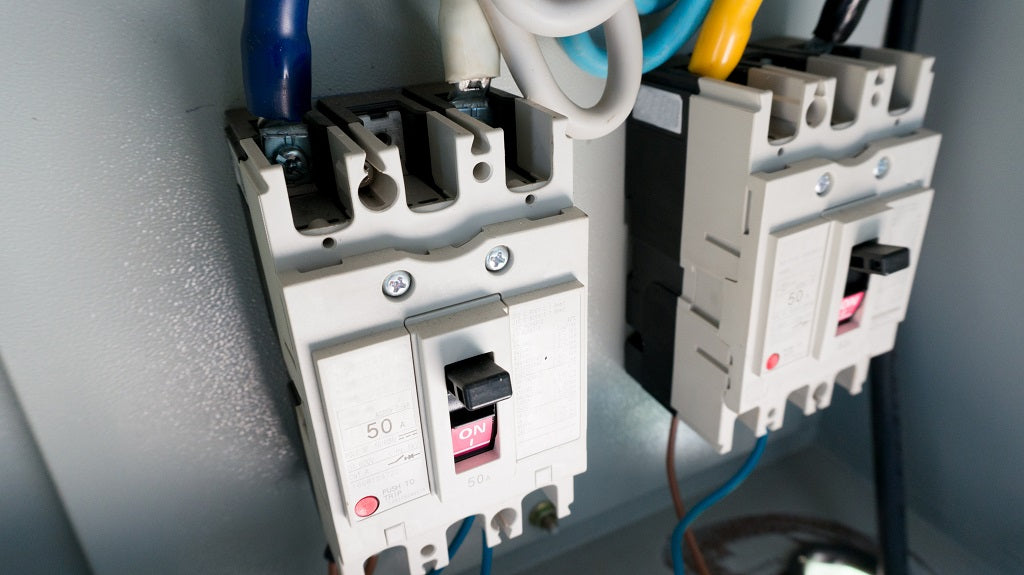Circuit breakers are electrical switches that protect the circuit breaker box from damage. The circuit breaker box houses an array of different domestic circuit breakers that are usually numbered to differentiate them. Once a circuit breaker in a house is pulled down, it switches the power off for that specific area of the house.
There is often a larger circuit breaker within the box that is called the main breaker, pulling down the main breaker results in cutting power off to the entire house. The damage that can occur is often caused by overcurrent/overload or short circuits which can happen for many reasons.
5 Main Circuit Breaker Components
5 main circuit breaker components function as a cohesive whole. These 5 components are the circuit breaker frame, the operating mechanism, the contacts, the trip unit, and an arc extinguisher.
Circuit Breaker Frame
The frame is considered the body of the circuit breaker. The frame provides a method for all required components to be mounted and kept in place, ensuring the proper circuit breaker usage. The frame is a protective case that provides insulation from the current. There are two types of circuit breaker frames.
The metal frame circuit breaker is made from precise metals that are bolted and welded together to form the frame. The molded, insulated material frames are made from strong insulating materials such as glass-polyester. Originally these types of circuit breakers in homes were used for low voltage circuit breakers, but since technology has progressed, these types of frames can now also be used in high voltage circuit breakers.
Operating Mechanism
There are two types of circuit breaker mechanisms: over toggle and two-step stored energy.
- Over toggle mechanism: This mechanism is called a Quick-Make or Quick-Break type, the speed at which the contacts open or close is not linked to how fast the handle is moved. This is a manual operator, but a motor operator can be used for this type of mechanism. This mechanism is designed to trip the contacts when required regardless of whether the handle is held ON or OFF position.
- Two-step stores energy mechanism: Is used when a lot of energy is required to close the circuit breaker and when it needs to close quickly. Unlike the over toggle mechanism, this type of mechanism uses independent opening and closing springs. This type of mechanism stores charged energy in a separate closing spring which provides safety due to the remote charging of the spring; and it can be operated remotely, which enhances safety for the operator.
Contacts

The contacts are a key element of a circuit breaker function, as they connect the circuit breaker to the system. They isolate a part of the domestic circuit breaker from the rest of the system. While a circuit breaker opens or closes, the fixed contact maintains the movable position from close (make) or open (break).
In other words, contacts play a simple role: they open and close the circuit breakers. They can do this manually, on-demand, or automatically depending on the type of breaker. The contacts are designed to protect the circuit breaker from an overcurrent (thermal overload) or short circuit (magnetic) or ground fault.
Trip Unit
A trip unit is like the brain of a circuit breaker box, it enables it to perform and respond to commands. Its function is to trip the operating mechanism in the event of a prolonged overload that could be caused by an overcurrent, short circuit, or ground fault.
There are two types of trip units:
- Electromechanical: This one is typically used in low voltage domestic circuit breakers. This type of trip unit uses bi-metal and electromagnets to protect the circuit breaker.
- Electronic: This type of trip unit interprets input current and decides based on the parameters. It offers many capabilities that are not present in the thermal-magnetic trip units such as diagnostics and testing capabilities.
Arc Extinguisher
An arc is an electric current discharge that happens when the contacts are opened, and an arc extinguisher is a component that will extinguish the arcs as they form in a domestic circuit breaker. This is a key element of a circuit breaker as it controls the extinguishers because arcs are inevitable. Arcs can be destructive in their intensity and their size, like a short current which is a devastating overcurrent condition.
Different Types of Circuit Breakers
There are three types of breakers: standard, GFCI, and AFCI. There is also another called the main breaker, which is larger than the others. Overall, these circuit breakers function rather similarly. The primary difference between types of breakers is what amp capacity they can handle. For example, most older breakers can be rated at 60 amps while the main breaker will mostly work on 100-amps or more. The other difference is that they operate in different locations of the home.
How Does a Circuit Breaker Work?
What is a circuit breaker and how does it work? Now that you can answer the first part of the question, it’s time to focus on the second. The role of domestic circuit breakers is to interrupt the flow of electrical current when it reaches a higher point than previously predetermined. The process is simple. The hot wire in the circuit connects to the two ends of the switch and this will move the contacts. The movement of the contact of the circuit breaker will determine when to shut off the flow of electricity for safety purposes.
Conclusion
Circuit breakers play a key role in home safety regarding using electricity. It is important to fully understand your circuit breakers and their composition to be able to buy electrical supplies that will properly protect your home. Blackhawk Supply sure a household circuit breaker is a necessity for every property, as it can protect your household appliances by shielding you from a current overload such as an overcurrent, short circuit, or a ground fault that could cause great damage. Don't hesitate to contact us!


